Tussilago, Coltsfoot, Kuan Dong Hua 款冬花CoughwortFarfara, Ungula Caballina (‘Horses Hoof’) Kuan Dong Hua (Flower) (TCM) |

|

|

|
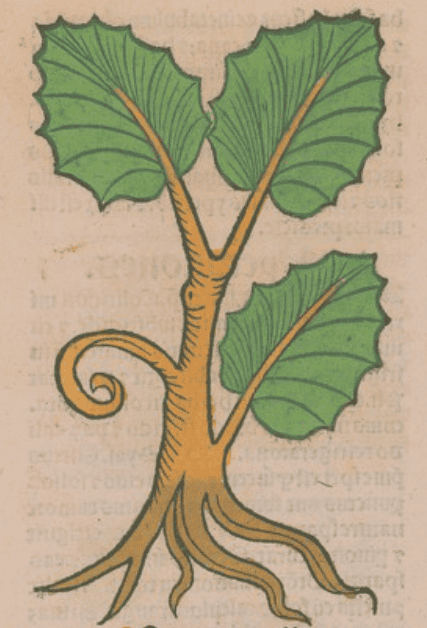 Ortus Sanitatis, Meydenbach, 1491
Ortus Sanitatis, Meydenbach, 1491
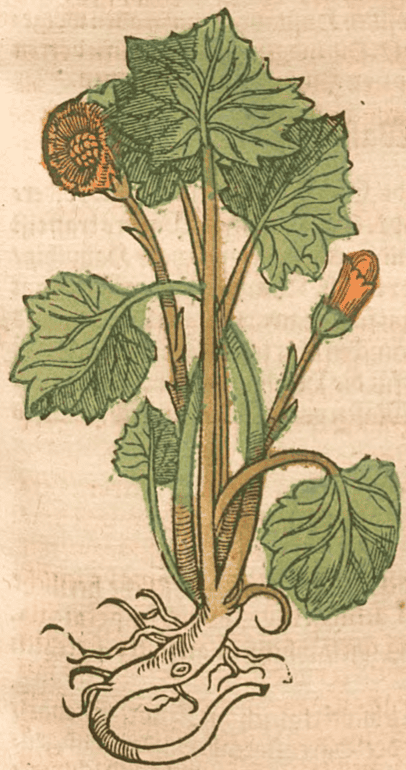 Krauterbuch, Lonitzer, 1578
Krauterbuch, Lonitzer, 1578 |
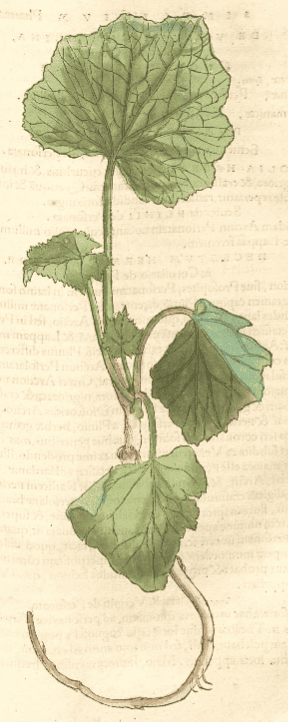 Herbarum Vivae Eicones, Otto Brunfels, 1530
Herbarum Vivae Eicones, Otto Brunfels, 1530 |
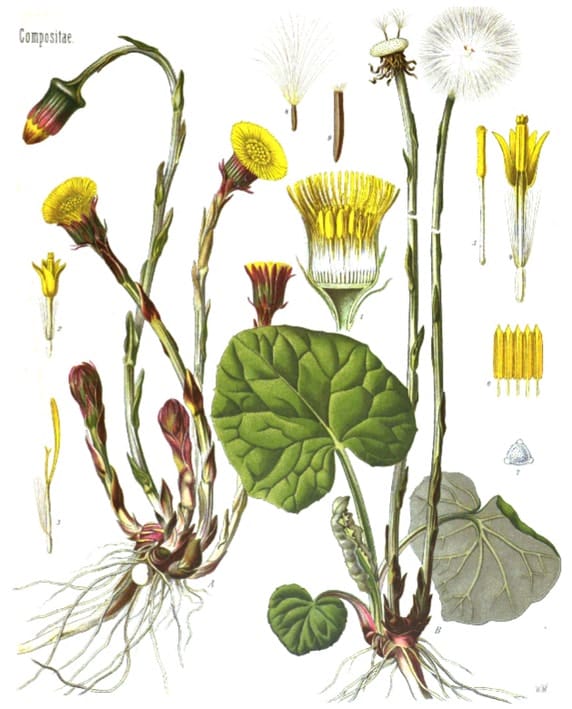 Kohler’s Medizinal Pflanzen, 1887
Kohler’s Medizinal Pflanzen, 1887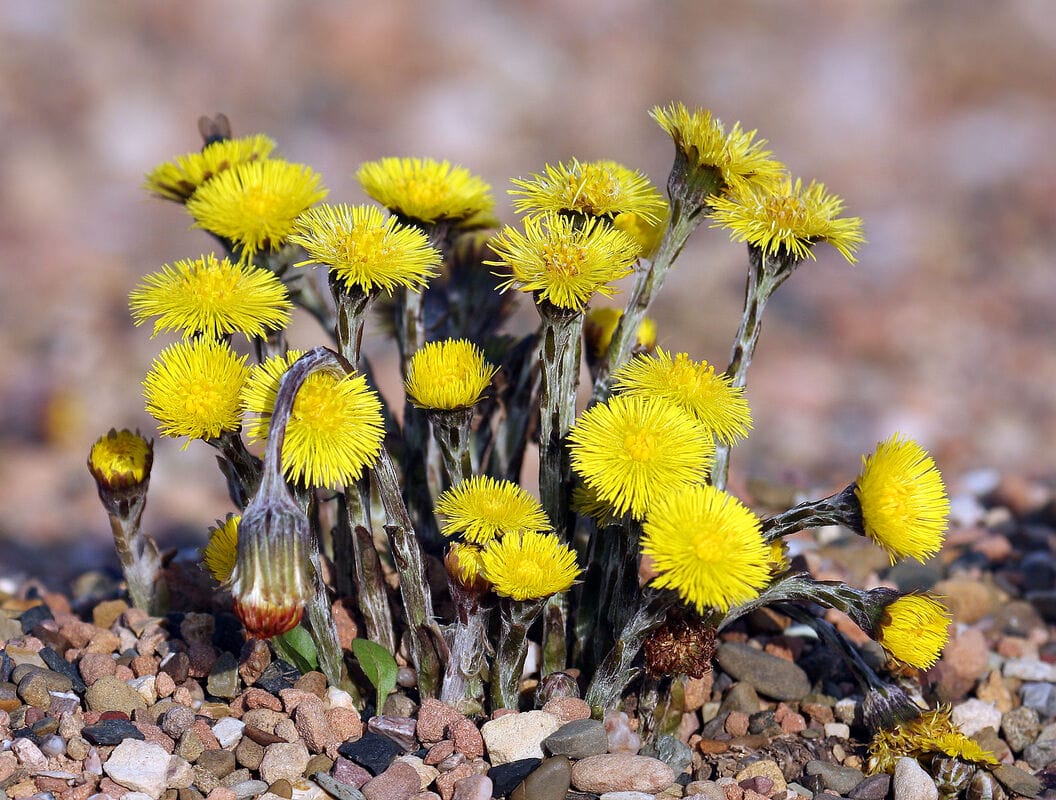 Coltsfoot
Coltsfoot(Photo by Andreas Trepte) (Wikimedia)
Botanical name:Tussilago farfara Parts used:Leaf; Flower; rarely the Root Temperature & Taste:Warm, dry. Pungent, sweet. Warm and Moist. (Avicenna) Classifications:2U. SUPPURATIVE 3K. EXPECTORANT. 3L. ANTI-TUSSIVE 4d. PECTORAL. 4k. ARTHRITIC Preparers and Purgers of Phlegm TCM: Q. Stop Cough and Wheezing |
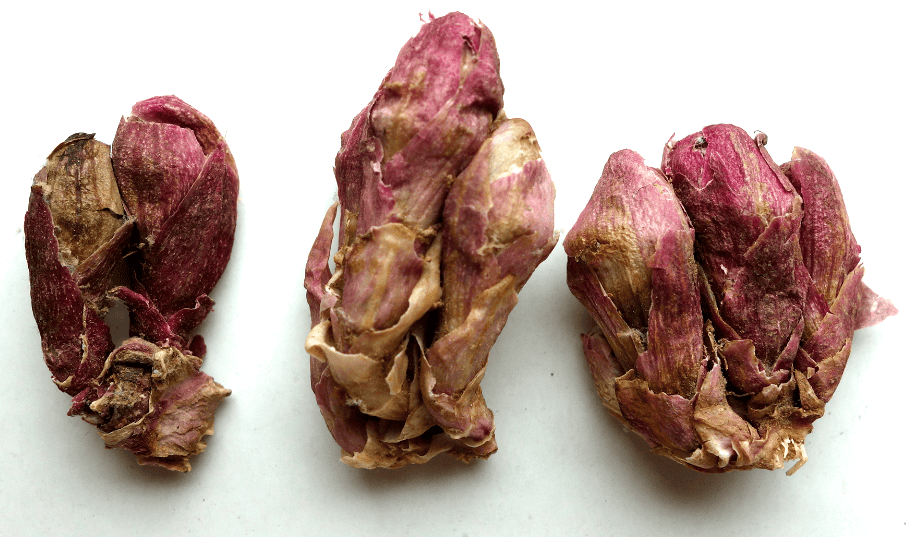 Coltsfoot Flower (Adam, 2016)
Coltsfoot Flower (Adam, 2016) |
Uses:
1. Benefits the Lungs, Clears Phlegm, Stops Cough and Wheezing:
-important medicine for all types of Cough, Wheezing and Lung diseases
–Bronchitis, irritating coughs, Whooping Cough
-Asthma, Pneumonia, Pleurisy
–Emphysema, Silicosis and the onset of Tuberculosis
-Lung abscess with blood and pius in the sputum (Zhen Quan)
-useful adjunct in Lung Cancer
-smoke was inhaled for Cough and Shortness of Breath (Dioscorides; also in TCM)
-advocated as beneficial for smokers
2. Clears Wind-Cold:
-Colds, Influenza, acute Fever, especially when with Cough
-acute Sore Throat, Throat Inflammation
-‘convulsions and epilepsy with chills and fever’. (Shen Nong Ban Cao)
3. Clears Phlegm, Resolves Swellings:
-Commended by some for Scrofula and Lymphatic nodes.
-Lung Abscess (Dioscorides)
4. Clears Damp, Promotes Urine:
-occasionally used for Cystitis, Burning Urine, Gravel, Stone
5. Moves the Blood, Promotes Menstruation:
-the root was used to expel a Dead Fetus (Dioscorides)
-Amenorrhea (Eclectics)
6. Externally:
-Scrofula, Nodes (poultice)
-Earache (oil as ear drops)
-poultices with Honey for Erysipelas and Bruises
-green leaves stamped with Honey is a good application to all inflammations and swellings.
-“Its leaves facilitate rupture of carbuncles and dissolve them in initial stages” (Avicenna)
-the leaves annointed with honey are applied to quickly heal Wounds.
-applied to Burns (Dioscorides)
-“Incorporated in the drugs prepared for strengthening the Eye-sight”. (Avicenna)
-Hydatids (cystic tumors caused by Tape Worms).
Dose:
The Leaf and Flower may be given in similar doses. It is best combined with Honey and/or Licorice for the Lungs. Larger doses are only used for short periods (1–2 weeks). Safe daily dose of the leaf and flower is generally given at 6 grams.
LEAF or FLOWER or WHOLE HERB in DECOCTION: 3–9 grams
POWDER: 1–3 grams
TINCTURE (1:5): 2–4mls
Preparation:
1. Scorched Coltsfoot Flower:
Used for Cold-Phlegm. It is given in the same doses as the Unprepared Flower; (TCM)
2. Honey Stir-fried Coltsfoot flower:
Better to moisten and strengthen the Lungs. It is taken in slightly larger doses.
3. Licorice-prepared Coltsfoot:
Soak the flowers in Licorice decoction, then remove and dry. It has similar effects to the Honey-prepared flower.
4. Alcohol-prepared Coltsfoot:
Sometimes in the West the leaves were sprinkled with Brandy, then dried. This makes it warmer, and more effective to clear Phlegm and open the airways.
Correctives:
1. Licorice
2. Apricot kernel (Xing Ren) can be used as its guiding drug. (TCM)
Main Combinations:
Coltsfoot & Licorice
Coltsfoot & Almond / Apricot kernel
1. Lung diseases in general:
i. cut the herb, mix with Pig lard and one Egg. Boil together in a pan and give to eat. Good for “all Griefs of the Lungs”, for Spitting Blood, and helps to fatten. (The Secrets of Alexis, 1595)
ii. Cotsfoot, Raisins, Licorice
iii. add Coltsfoot to Pectoral Decoction
2. Cough:
i. Coltsfoot flower decocted with Raisins (Herbarium Horstianum, 1630)
ii. Coltsfoot with Maidenhair and Licorice (as in Syrup of Coltsfoot)
iii. Coltsfoot with Licorice, Red Poppy flower, Aniseed (Pharmacopoeia Castrensis Borussica, 1823)
iv. Chronic Cough, Coltsfoot with Pennyroyal and Parsley
v. obstinate Cough, Coltsfoot with Ground Ivy, Licorice, Raisins, Almond, Cinnamon, Clove (Pharmacopoeia Generalis, 1783)
vi. mix the flowers with a little honey, burn and inhale the fumes. (Su Song). Inhaling the fumes was said to have been effective in chronic cough (Li Shi Zhen)
3. Bronchitis:
i. Coltsfoot, Plantain
ii. Coltsfoot with Licorice, Mallow flowers, Thyme, Aniseed
4. Asthma:
i. Coltsfoot with Bitter Almond, Licorice, Maidenhair
ii. Coltsfoot with Mullein, Calamus, Asarum, Juniper berry
iii. Coltsfoot with Ephedra Ma Huang, Almond, Licorice (TCM)
5. Cold with Cough, Coltsfoot with Elder flower and Peppermint
6. Lung deficiency, Consumption:
i. Coltsfoot with Dates, Figs, Raisins, Licorice
ii. Coltsfoot, Almonds, Pine nuts, Raisins, Jujubes
iii. Coltsfoot with Asparagus root, Elecampane, Licorice
7. Lung Ulcers:
i. Coltsfoot with Melon seed, Rosemary, Borage, Violet
ii. Coltsfoot with Plantain and Comfrey
8. Lung Cancer:
i. Coltsfoot, Violet, Plantain, Herb Robert
ii. Coltsfoot, Bitter Almond, Comfrey, Black Nightshade, Licorice
9. Lung Abscess:
i. Colstfoot, Figs, Barley
ii. Coltsfoot with Barley, Hyssop
iii. Coltsfoot with Violet, Dandelion
iv. Coltsfoot with Hyssop, Figwort root
10. Pleurisy, Coltsfoot with Nettle, Camomile, Aniseed
11. Fever, Coltsfoot with Elder flower and Black Nightshade (equal parts of the Distilled Waters)
12. Gravel, Stone, Coltsfoot with Wormwood
13. Scrofula:
i. Coltsfoot, Hyssop, Balm
ii. beat Coltsfoot with root, mix with Linseed meal and form an ointmen (traditionally with Barrow’s Grease), and apply. (The Secrets of Alexis, 1595)
14. Smoking Blend for Asthma and Bronchitis, Coltsfoot with Thyme, Eyebright and Lavender
Major Formulas:
Decoction of Hyssop and Coltsfoot (Wirtzung)
Decoction to Strengthen the Lungs
Decoction of Horehound
Pectoral Decoction (London, 1650)
Syrup Against Consumption
Syrup of Coltsfoot Compound
Syrup for Asthma (Wirtzung)
Anti-Asthmatic Syrup (D’Aquin)
Syrup of Horehound (Fernelius)
Electuary of Coltsfoot Magisterial
Pectoral Powder
Ding Chuan Tang
Jiu Xian San
Cautions:
1. Not used during Pregnancy or Breastfeeding; use carefully in children
2. Avoid overdose; Should not be used long-term
3. Avoid in those with Liver disease
Toxicity:
The alkaloids in Coltsfoot have been shown to be hepatotoxic, and at least one compound is carcinogenic. Animals fed large amounts (32% of their diet for 4 days, followed by 16% for the remainder of the 600 day long trial) of Coltsfoot developed Liver Cancer, whereas 1 out of 10 receiving 8% Coltsfoot in their diet developed tumors, while none receiving 4% Coltsfoot developed tumors.
However more recent studies showed Coltsfoot does not cause damage to human chromosomes, and is therefore probably not carcinogenic to humans, at least in therapeutic doses. The toxic alkaloids are said to be destroyed by boiling. Older herbalists regularly gave Coltsfoot alone or in combination for months in chronic Lung complaints with no noted ill effects.
–A systematic review and quality assessment of case reports of adverse events for borage (Borago officinalis), coltsfoot (Tussilago farfara) and comfrey (Symphytum officinale).
–Oral toxicity study of certain plant extracts containing pyrrolizidine alkaloids.
Main Preparations used:
Distilled Water, Syrup, Conserve
1. Conserve of Coltsfoot:
i. Coltsfoot flower (1 part). White Sugar (2 parts). Beat.
2. Syrup of Coltsfoot:
i. fresh Coltsfoot flower (4 lbs.), Boiling Water (8 lbs.). Infuse 24 hours, express slightly and add White Sugar (twice the quantity), Dissolve. (Pharmacopoeia Gallica, 1818)
3. Distilled Water of Coltsfoot:
i. Coltsfoot flower (1 part), Water (3 parts). Distil 1½ parts. (Dispensatorium medico pharmaceuticum Palatinatus, 1764)
- Extra Info
-
Research
